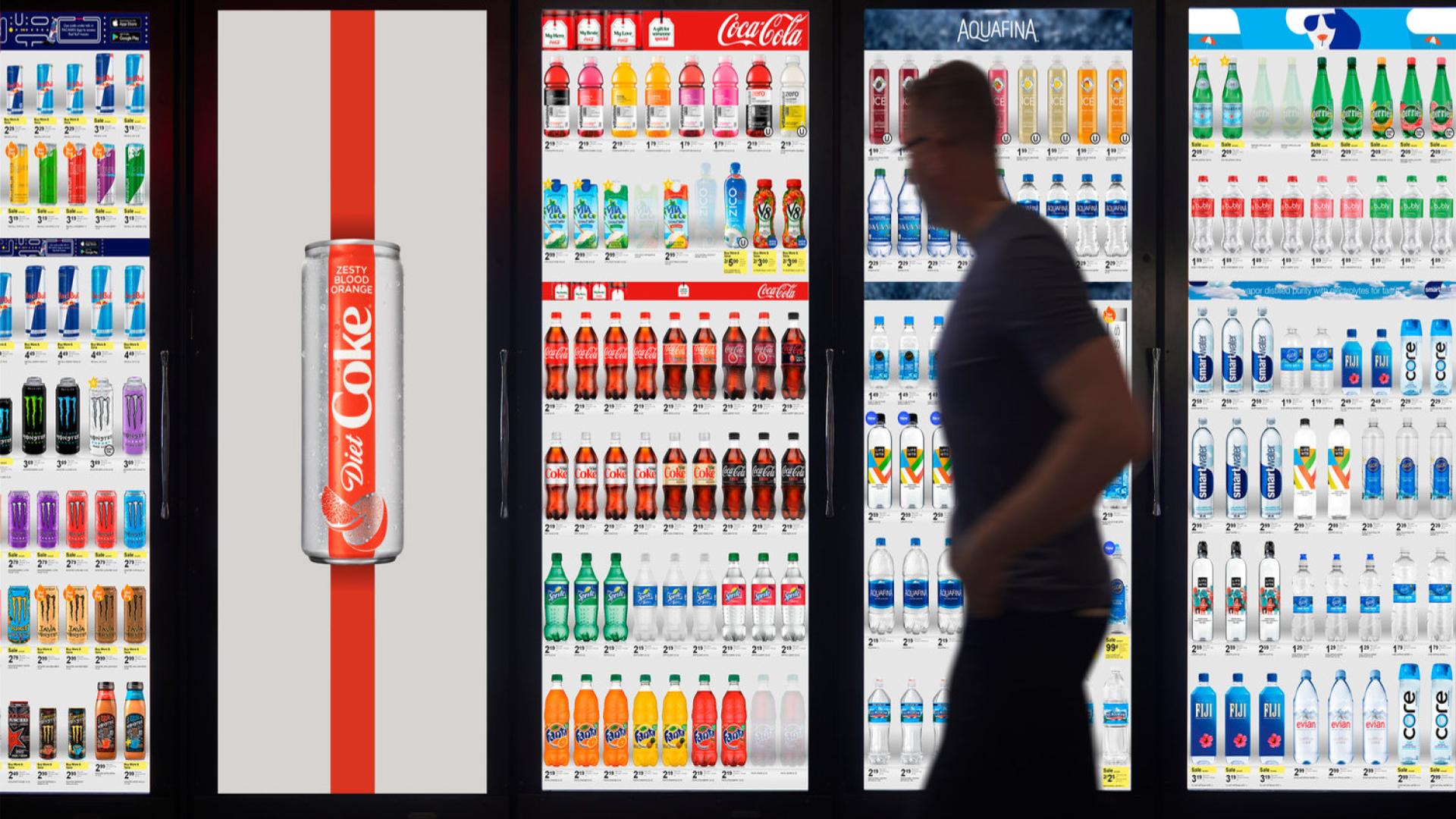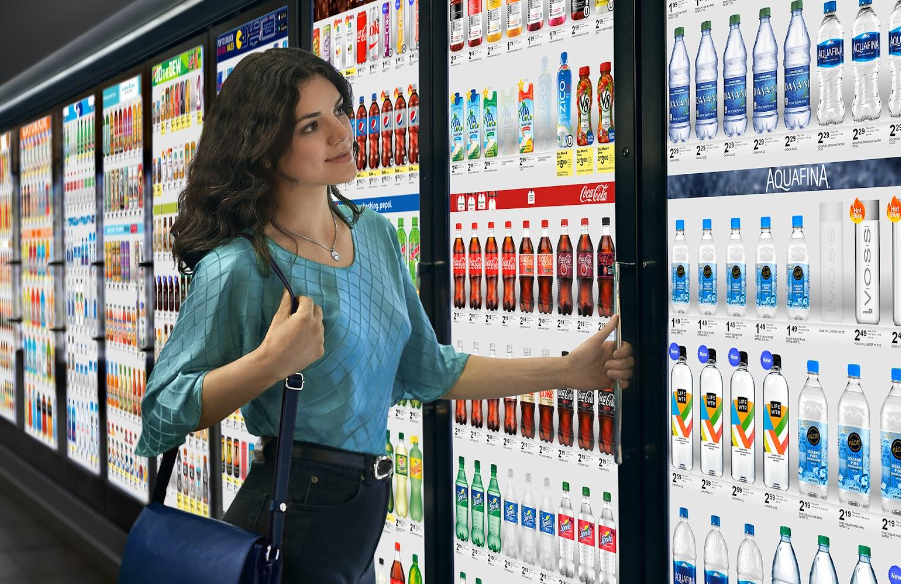Cooler Screens: What Is It Other Than Cool and Why It’s Here To Stay

The retail landscape is changing, technology is evolving, and consumers’ expectations are higher than ever before. Cooler Screens, a company dedicated to transforming retail surfaces into digital IoT-enabled smart screens, is on the forefront of innovation in the brick-and-mortar space. Their cooler screen doors can be found in freezer and refrigerator aisles in 700+ national grocery, drug, and convenience stores across the U.S.
The company’s mission is to provide an enhanced shopping experience to consumers while also catering to retailers and product brands. We sat down for a Q&A with Lindell Bennett, Chief Revenue Officer at Cooler Screens to learn more about the company’s technology, what the future holds for their business, and the important intersection between retail and media.

A: The origin story of Cooler Screens is pretty interesting and that’s partly what drew me to my current role after working at Amazon for 10 years. Our CEO, Arsen Avakian, previously had an independent tea brand named Argo Tea. At the time, he looked into how his tea compared to others in the market. He would look down the aisles of Kroger and Walgreens and started to ask himself, “Where’s the innovation?” People are looking at their phones all the time while they’re standing in the aisle, and Avakian wondered how he could increase the innovation of the in-store experience to better cater to customers. Consumers can be bifurcated between their phones and between the physical appearance of the canvas that they’re looking at. At that moment, they are trying to figure out the nutritional value of the item they are considering [among other things] and they are ultimately trying to make the best decision for themselves. So there was born the idea for Cooler Screens, which started with the cooler door and asking ourselves, “How do we make the cooler door a more engaging experience?”
Cooler doors are essentially a six-foot canvas in high-traffic areas where people are considering items to purchase. This idea took Avakian’s focus away from tea and put his attention on increasing engagement in the in-store experience, beginning with the cooler door. So out of that was born our vision of becoming the leading digital in-store media platform for any surface. Cooler doors are our focus today, but the possibilities are really endless in this space.

A: At Cooler Screens, we are centered around consumers. At the end of the day, if a customer doesn’t like what they’ve seen or has poor feedback, we take that very much to heart. We have internal reviews that we do every single week where we examine the data surveys we are taking in from the fields. When we take these surveys, we are learning directly from consumers. We’re trying to see if they are having a positive experience, a neutral experience, or a negative experience with our digital cooler doors. And by and large, when we get these surveys back it’s around 70% positive, 20% neutral, and 3% to 5% negative. We, of course, want 100% positive, but we’re trying to take all of that information in so we can learn from it. We are constantly asking ourselves, “Are we going up? Are we going down? Are the neutrals growing? What’s happening with the negatives?”
We also have a similar relationship with our retailers. We want to be able to provide them with all the data that they need to understand how people are interacting. What are the responses that they’re getting? What is this doing for their business? There’s a lot of inherent value for the retailer in just learning more about consumer engagement and intent with the door.
A: Privacy is a key pillar for us and this was a very intentional decision for Cooler Screens to be identity-blind. It’s important for consumers to know that we don’t use cameras. When we have our screens facing you, we don’t know if it’s you, if it’s me, or if it’s somebody else. We know that there is a human being and that they’re paused in front of our doors.
The in-store experience, yes it’s changed, but adding a digital element is a much bigger change than having things on the shelves, physical end caps, signage, etc. We are very sensitive to that and it’s a very important thing to be certified as identity-blind. For us, this is a key pillar that we plan on keeping and maintaining with all the vigor that we have because we want people to feel comfortable. We want consumers to be able to enjoy their shopping experience, and not be distracted by the question of, “Oh are they watching me?” “What does this mean for me?” “Do I want to be in this store?” We don’t even want that to be a question. It’s very important that we are upfront and out loud about the fact that we are identity-blind. It is sensors that detect motion, not cameras, and that’s where our focus is.
A: When you think about the in-store experience, 80% of people that walk into a store are going to buy something, 82% of those people don’t know exactly what they want to buy, and 62% of people are open to an impulse buy. So now, you have this awesome situation where they’re in the context and the mindset of shopping and buying. They haven’t necessarily fixated on whether they want this brand or that brand, and they’re open to impulse buying. So for us, when you think about it within the context of “I’m in front of an ice cream door and I want to buy,” you have the ability to isolate the message to exactly what a consumer is focused on at this point in time based on the distance that they are from the door.
The way that the technology works is when a person is six to 12 feet away from the door, our sensors can detect that there’s a human shape paused in front of the door. If a consumer is six to 12 feet away, we present them with a full-door ad. In the cooler area, that’s roughly a six-foot canvas with a 4K resolution where brands can share their message with a captive audience. From there, let’s say that they engage with a brand. They’d like a particular item and they step forward within six feet and then all of a sudden the cooler door screen switches to the planogram because we want the consumer to be able to see what options there are behind the cooler door.
From there, at the eyeball level, there’s a banner and at the top level users will see an additional banner. So all of a sudden you’ve gone from what is roughly awareness at six to 12 feet away to consideration once you’re within six feet. When a consumer is paused at the cooler door, we can actually have what is almost like a last-minute retargeting ad that comes up, which is a square unit called the spotlight.
In previous positions, in order to sequentially message in that way from awareness to consideration to purchase, I would’ve had to go through a variety of avenues from say an OTT ad to display retargeting to search. This means multiple sessions from different devices. What was intriguing to me about Cooler Screens is that we can do that within a matter of feet while consumers are in that physical location about to buy something.

A: It’s a great question and again, cooler doors are where we started. We will branch out to other areas, but the cooler door is an extremely high-traffic area. When our CEO was focused on Argo Tea, he wanted a way to give consumers deeper information about how his product stood apart from the competition. He wanted to create an easier way for customers to know that his tea was organic and free from sugar. He thought how much more powerful it would be for brands to share qualitative information on labels via the cooler door rather than solely running promotions or discounts.
What we’re trying to do is not just to provide a screen to replace the transparency of the door, we’re trying to provide the opportunity for brands to differentiate themselves. We give brands the chance to do just that as they can add a digital tag on their product (with additional information) that’s shown on the planogram. It’s a game changer for a lot of brands, especially if they’re trying to present some sort of value that’s not apparent based on the price.
A: Right now, the screens are found on the cooler doors. If there’s a user that’s paused six to 12 feet away, they will see a six-foot tall full door ad, in 4k resolution with video capabilities. It’s an incredible visual opportunity and people typically dwell on that ad for six to eight seconds. So from a brand messaging perspective, if you have some sort of a lifestyle campaign, a messaging campaign, or a product launch, where else are you going to get a six-foot, 4k opportunity with six to eight seconds of dwell time? That’s a huge opportunity for brands to be able to speak their message in-store at the point of purchase.
That’s one way to look at it. But then, let’s say that that person engages with that ad, and again, they move forward within six feet. The cooler screen door then changes to the planogram where a brand can then do that sequential messaging via banner ads. It’s awareness, consideration, and purchase, all in that proximity, but in a matter of feet, not in a matter of sessions, not in a matter of clicks.
One really interesting point is that over half of the advertisers we work with are not behind the cooler door – they are somewhere in the middle of the store. As we know, the cooler aisle gets a ton of traffic. But how do we get those people that are buying milk, soda, water, etc. to turn their attention to different areas of the store? There are all sorts of opportunities there, so one really eye-opening thing to me is, you naturally think, “Oh, they sell carbonated soft drinks, and they’re in front of a carbonated soft drink door. We should definitely be there, and be speaking to them.” 100%, you should.
But what has been really eye-opening to me is the interest from people who sell shelf-stable cheese, who sell detergent, who sell face cream. All these other areas that are not inherent to the cooler are also of great excitement and opportunity for those types of brands because they want to drive traffic to those aisles. So over half of our business today comes from those middle aisle categories, and I think that’s just been the most exciting thing, is that it opens up the whole store. It’s the shopper journey within a physical location, and we can help drive that influence to another part of the store.”
A: Today, our footprint is more than 700 stores nationally across drug store chains, convenience store chains, and grocery. We have 10,000 screens and we reach around 95 million people a month. We want to have all the channels covered, and we would love to have a major partner in each of those categories.
Our footprint is going to double in the next year, and that’s us being conservative. The areas where we’re going to see a lot of expansion are convenience and grocery. Brick-and-mortar is back and we’re constantly asking ourselves, “How do we get our footprint as big as we can across as many channels as we can today to really provide a full spectrum experience for those brands?”
We have big news to share in the coming months when it comes to partnerships so stay tuned.

A: When you think of retail media today, call it 99% of the time, it’s about e-commerce and that’s fair because there’s so much measurement, so much rich data, so much ability to speak back to what is actually happening and what are people doing. But when we consider that 90% of food, beverage, and CPG purchases are happening in-store, how do we take the same mentality, the same measurement abilities, and bring those to the in-store experience?
I think as Cooler Screens steps forward, yes, it is a media opportunity and that media opportunity is going to span to not only more retailers, more kinds of retailers, more channels, and more areas of the store, but it’s also going to marry together the media opportunity with the measurement opportunity. That’s our ambition. So I think as you start seeing press releases from Cooler Screens, my hope is that you’re going to see some really big retailers out there that are partnering with us.
We want to bring measurement to the forefront of what we’re doing because when you combine the media with the measurement in a unique and compelling way, that’s really where the magic happens. So our ambitions are not just to digitize the physical canvases, that is a part of it, but those sensors, the experience, the way that we’re able to help understand what customers are doing in-store, that opens up a whole new world of opportunity that doesn’t exist in the same way today.
So it’s a big ambitious goal and dream, but that’s where we’re at and I think those are the conversations that really open people’s eyes. So if I’m talking to an agency holding company, if I’m talking to a brand, if I’m talking to a programmatic team, whoever I’m talking to, when we start talking about the language of retail media, of online, e-commerce, etc., and we bring it into the physical world, it’s like wow, the lights go on. So we’re not exactly there yet today, we’re working on that fast and furious. When we can bring those two things together, that is going to be a very powerful moment and that’s what we’re working towards.
